| Notes: The West Midlands Railway (WMR) was formed on 14 June 1860 with the union of the Oxford, Worcester & Wolverhampton Railway (OW&WR) and the Newport, Abergavenny & Hereford Railway (NA&HR).
On 17 July 1862 the WMR Additional Works Act authorised the construction of two branches radiating from Old Hill. The first was to run in a northerly direction to Blowers Green Junction, near Dudley, and connect with the GWR’s Stourbridge Junction to Wolverhampton Low Level line. The second would run south to Halesowen with an end-on connection with the proposed Halesowen & Bromsgrove Branch Railway (HB&BR). On 1 August 1863 the WMR was amalgamated with the GWR: a shrewd move by the GWR as it would deny the LNWR access via Smethwick to Stourbridge and allow direct access to Birmingham. In the 1860s any trains from the Stourbridge direction for Birmingham had to travel via Dudley and reverse at Wolverhampton Low Level, substantially increasing the journey time.

The Old Hill to Blowers Green line, or the ‘Bumble Hole’ line as it was christened, was opened on 1 March 1878 by the GWR. The line became known as the Bumble Hole line as it passed through an area of that name close to Windmill End. Construction of the line had not been easy as the route took in heavily industrialised areas and would have to cross the Dudley Canal near Windmill End. Expenditure on bridges and earthworks to by-pass many of the mining activities was vast and would have probably bankrupted an independent company.
Windmill End was the only intermediate station along the branch when it opened with the line on 1 March 1878. It comprised two lengthy platforms of brick construction supported by large timbers, with a brick surface within the immediate proximity of the station buildings and ash surface 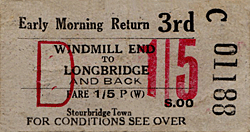 elsewhere. A large building of wooden construction was provided on the Dudley direction platform with a slightly smaller waiting room in the same material provided on the opposite platform; both buildings lacked architectural distinction. However, each was provided with a flat awning with a shallow serrated valance, supported by timber pillars. A footbridge was provided to enable passengers to cross to the up (Old Hill) direction platform. The station staff comprised a stationmaster and porter who were kept particularly busy on Monday mornings when the weekly tickets were in demand before the 7.00am departure. It was not unknown for the stationmaster to cross the footbridge to look for late arriving passengers and occasionally lift a person up from the trackside to help them into a carriage. Vehicles and pedestrians could reach the down platform of the station via a ramp at the side of the Bullfield’s Hotel on Windmill End (road). There was also a pedestrian footpath up to the station site from a little further east along Windmill End (road). elsewhere. A large building of wooden construction was provided on the Dudley direction platform with a slightly smaller waiting room in the same material provided on the opposite platform; both buildings lacked architectural distinction. However, each was provided with a flat awning with a shallow serrated valance, supported by timber pillars. A footbridge was provided to enable passengers to cross to the up (Old Hill) direction platform. The station staff comprised a stationmaster and porter who were kept particularly busy on Monday mornings when the weekly tickets were in demand before the 7.00am departure. It was not unknown for the stationmaster to cross the footbridge to look for late arriving passengers and occasionally lift a person up from the trackside to help them into a carriage. Vehicles and pedestrians could reach the down platform of the station via a ramp at the side of the Bullfield’s Hotel on Windmill End (road). There was also a pedestrian footpath up to the station site from a little further east along Windmill End (road).
During the 1930s the station’s waiting room was not only popular with passengers, but with local lads. The 1974 book By Rail to Halesowen by Michael Hale and Ned Williams notes; ‘Local lads were often to be found sitting round the waiting room fire; the station seems to have been a popular social circle in the thirties!’
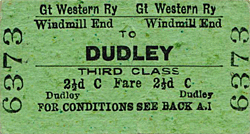 The station was designated a ‘Halt’ in 1952, probably on 15 September when the winter timetable was introduced and had its permanent staff withdrawn although a booking clerk would be sent down from Old Hill to issue tickets during the busiest periods. The large platform building started to suffer from the attention of vandals and from a lack of maintenance and by 1955 the structures on both platforms were in a terrible state, especially the waiting room on the up platform (Old Hill direction) which was a mere shell whose canopy was virtually roofless. The station was designated a ‘Halt’ in 1952, probably on 15 September when the winter timetable was introduced and had its permanent staff withdrawn although a booking clerk would be sent down from Old Hill to issue tickets during the busiest periods. The large platform building started to suffer from the attention of vandals and from a lack of maintenance and by 1955 the structures on both platforms were in a terrible state, especially the waiting room on the up platform (Old Hill direction) which was a mere shell whose canopy was virtually roofless.
The Western Region of British Railways undertook a rebuilding programme of the halts along the line from 1957 onwards, and the changes made at Windmill End were quite dramatic. The platforms were considerably reduced in length and the timber supports were removed with new concrete platform faces added. The original platform buildings were demolished with the down direction (Dudley) building being replaced with a white painted corrugated iron hut to accommodate the part-time booking clerk. It had a flat roof-cum canopy which projected out, 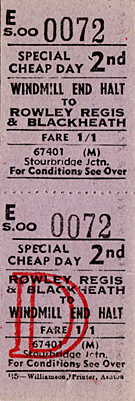 partially, over the platform. The canopy was supported by timbers projecting out at a 45 degree angle from part way up the front panel of the hut. The up direction (Old Hill) was replaced with a corrugated iron clad shelter supported by pre-cast concrete columns. Electric lighting replaced gas and totem nameplates were installed. partially, over the platform. The canopy was supported by timbers projecting out at a 45 degree angle from part way up the front panel of the hut. The up direction (Old Hill) was replaced with a corrugated iron clad shelter supported by pre-cast concrete columns. Electric lighting replaced gas and totem nameplates were installed.
Sometime after 1957 the footbridge was found to be unsafe and was dismantled and replaced with a barrow crossing at the southern end of the halt, whilst the booking office and platform shelter were replaced with ones in keeping with the halts on the rest of the branch.
Bradshaw’s December 1895 shows nine up (Dudley to Old Hill) and eight down services on Monday-to-Saturday with no Sunday trains. By July 1922, and with the opening of the intermediate halts, the service had improved dramatically with 21 up services; two did not call at the halts, and there was one through service from Birmingham. In the down direction there were 22 services, with five not calling at the halts and one through to Birmingham.
The line was renowned for its poor riding qualities owing to extensive mining activities in the area and the subsidence this caused. Passenger loadings along the line were never high enough to warrant anything more than the provision of a single GWR rail-motor or a Collet/Pannier tank engine and a single coach.
At the time of the Grouping, 1 January 1923, the line came under the control of the GWR and services continued much as they had for the previous 25 years. With nationalisation of the railways 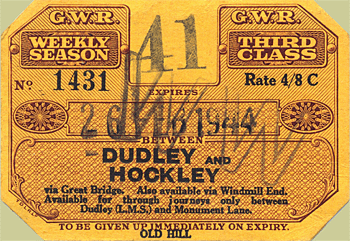 on 1 January 1948 the line fell under the control of British Railways Western Region who decided that the halts along it would require rebuilding, so from 1957 through to 1960 the halts from Old Hill High Street to Baptist End, inclusive, were rebuilt. At Windmill End the wooden platform supports and surface were replaced with pre-cast concrete. The waiting shelters were rebuilt with pre-cast concrete supports clad with corrugated iron partially enclosed but giving little protection from the elements; a roof-cum-canopy projected over the platform. Gas lighting (of a style more commonly associated with the LMS) was also replaced with electric and totems were attached to the lighting columns, allowing the dilapidated GWR running-in boards to be removed. on 1 January 1948 the line fell under the control of British Railways Western Region who decided that the halts along it would require rebuilding, so from 1957 through to 1960 the halts from Old Hill High Street to Baptist End, inclusive, were rebuilt. At Windmill End the wooden platform supports and surface were replaced with pre-cast concrete. The waiting shelters were rebuilt with pre-cast concrete supports clad with corrugated iron partially enclosed but giving little protection from the elements; a roof-cum-canopy projected over the platform. Gas lighting (of a style more commonly associated with the LMS) was also replaced with electric and totems were attached to the lighting columns, allowing the dilapidated GWR running-in boards to be removed.
A major revision of British Railways regional boundaries took place on 1 January 1963 when the Bumble Hole line was transferred to the London Midland Region (LMR). The ‘Beeching Report’ of March 1963 sounded the death knell for the passenger service with its withdrawal being 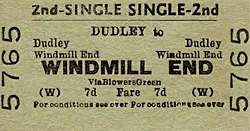 recommended. As seen on other recently transferred lines in the area, the LMR had no sentimental attachment to former GWR routes. The official proposal to close the line was published on 2 August 1963 and on 30 April 1964 the Secretary of State for Transport gave his consent. The final service was scheduled for Saturday 13 June 1964, a little over a year after the initial recommendation, and the official date of closure was 15 June. Some stations along the line saw as little as one passenger a day. recommended. As seen on other recently transferred lines in the area, the LMR had no sentimental attachment to former GWR routes. The official proposal to close the line was published on 2 August 1963 and on 30 April 1964 the Secretary of State for Transport gave his consent. The final service was scheduled for Saturday 13 June 1964, a little over a year after the initial recommendation, and the official date of closure was 15 June. Some stations along the line saw as little as one passenger a day.
It is hardly surprising that the service from Windmill End was little used when the times are closely examined in the extract from B.R. London Midland Region timetable 17 June 1963 to 8 September 1963.
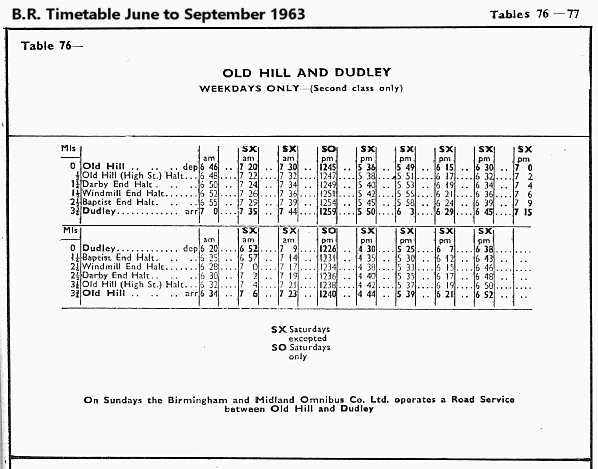
All of the up and down early morning services departed within an hour although the evening service was a little more spread out but the latest departure from Dudley was 6.38pm and 7.00pm from Old Hill. A large gap in service Monday to Friday of over 10 hours in the Dudley direction and a nine hour gap in the opposite direction, excluded all casual daytime travellers. On Saturday the service was even worse with one early morning departure either way and a Saturday Only lunchtime working, meaning travellers using the afternoon service could get to their destination and not get home! This absurd timetabling effectively killed off any demand there could have been for the service.
In June 1964, the Wolverhampton Express & Star prepared an obituary of the Bumble Hole line passenger service.
Not many will mourn its passing, except maybe for pangs of nostalgia. It has had its day. But in the past there is no doubt that it provided a greater service for the community.
The paper went on to quote Guard Bishop of the 6.30pm from Dudley.
If we get one passenger on this particular train, that’s as many as we’ll ever get. We may get him twice a week and he usually gets off at Windmill End.
British Railway's LMR prepared it's own black boardered obituary;
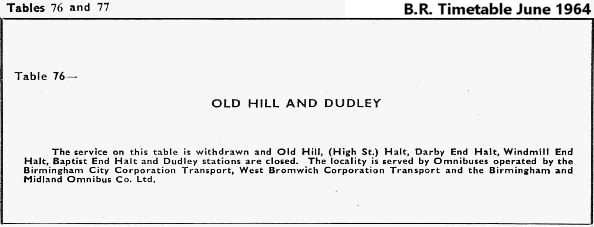
Following the withdrawal of the passenger services, goods trains continued to use the line. Near Baptist End there was a junction to the Netherton Goods (formerly Withymoor basin branch until 1 August 1921) but this branch closed on 5 July 1965. The sparse remaining traffic lingered until 1 January 1968 when the line officially closed, the track being lifted shortly after.
Today, the station site can still be reached by the vehicular ramp from the side of what was the Bullfield’s Hotel (now flats), but all trace of the station and the embankment on which it once stood have been swept away. The only evidence of there ever being a railway there is a small section of brickwork from the bridge which spanned the Dudley Canal which is embedded in the towpath.
Tickets from Michael Stewart , route map by Alan Young and Totem from Richad Furness
Sources:
- Bradshaw's December 1895 Railway Guide - Middleton Press 2011
- Bradshaw's July 1922 Railway Guide - David & Charles 1985
- By Rail to Halesowen - Michael Hale & Ned Williams - Michael Hale Publishing 1974
- Forgotten Railways: Volume 10 The West Midlands - Rex Christiansen - David St John Thomas Publisher 1985
- A Regional History of the Railways of Great Britain - Volume 7 The West Midlands - Rex Christiansen - David St John Thomas Publisher 1995
- Lost Lines Birmingham & the Black Country - Nigel Welbourn - Ian Allan Publishing - 2002
-
To see stations along the Bumble Hole click on the staiton name:
Old Hill High Street Halt, Darby End Halt & Baptist End Halt
See also:
Old Hill, Blowers Green & Dudley
|

end_old1.jpg)
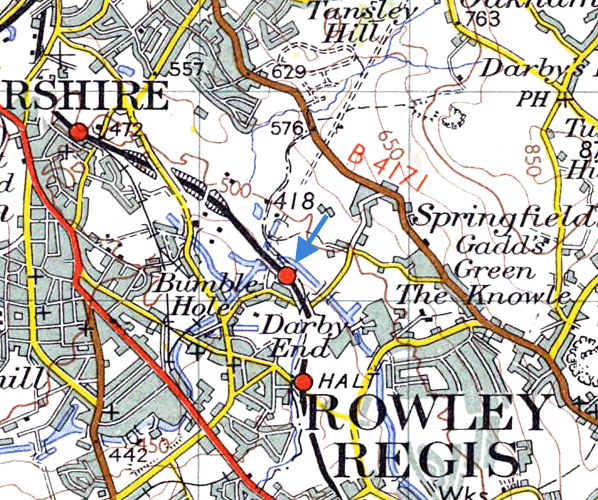
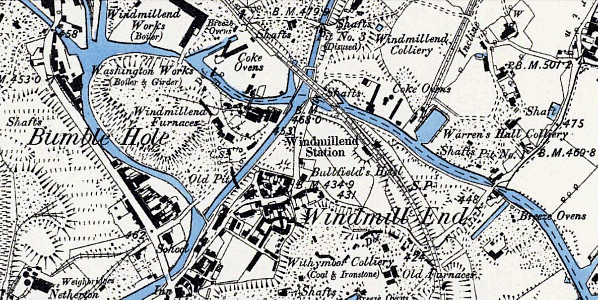
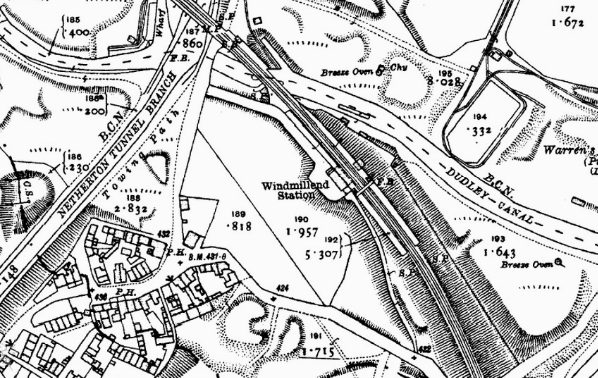
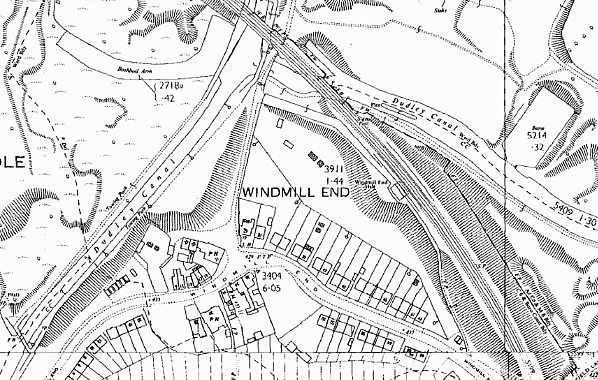


 elsewhere. A large building of wooden construction was provided on the Dudley direction platform with a slightly smaller waiting room in the same material provided on the opposite platform; both buildings lacked architectural distinction. However, each was provided with a flat awning with a shallow serrated valance, supported by timber pillars. A footbridge was provided to enable passengers to cross to the up (Old Hill) direction platform. The station staff comprised a stationmaster and porter who were kept particularly busy on Monday mornings when the weekly tickets were in demand before the 7.00am departure. It was not unknown for the stationmaster to cross the footbridge to look for late arriving passengers and occasionally lift a person up from the trackside to help them into a carriage. Vehicles and pedestrians could reach the down platform of the station via a ramp at the side of the Bullfield’s Hotel on Windmill End (road). There was also a pedestrian footpath up to the station site from a little further east along Windmill End (road).
elsewhere. A large building of wooden construction was provided on the Dudley direction platform with a slightly smaller waiting room in the same material provided on the opposite platform; both buildings lacked architectural distinction. However, each was provided with a flat awning with a shallow serrated valance, supported by timber pillars. A footbridge was provided to enable passengers to cross to the up (Old Hill) direction platform. The station staff comprised a stationmaster and porter who were kept particularly busy on Monday mornings when the weekly tickets were in demand before the 7.00am departure. It was not unknown for the stationmaster to cross the footbridge to look for late arriving passengers and occasionally lift a person up from the trackside to help them into a carriage. Vehicles and pedestrians could reach the down platform of the station via a ramp at the side of the Bullfield’s Hotel on Windmill End (road). There was also a pedestrian footpath up to the station site from a little further east along Windmill End (road). The station was designated a ‘Halt’ in 1952, probably on 15 September when the winter timetable was introduced and had its permanent staff withdrawn although a booking clerk would be sent down from Old Hill to issue tickets during the busiest periods. The large platform building started to suffer from the attention of vandals and from a lack of maintenance and by 1955 the structures on both platforms were in a terrible state, especially the waiting room on the up platform (Old Hill direction) which was a mere shell whose canopy was virtually roofless.
The station was designated a ‘Halt’ in 1952, probably on 15 September when the winter timetable was introduced and had its permanent staff withdrawn although a booking clerk would be sent down from Old Hill to issue tickets during the busiest periods. The large platform building started to suffer from the attention of vandals and from a lack of maintenance and by 1955 the structures on both platforms were in a terrible state, especially the waiting room on the up platform (Old Hill direction) which was a mere shell whose canopy was virtually roofless. partially, over the platform. The canopy was supported by timbers projecting out at a 45 degree angle from part way up the front panel of the hut. The up direction (Old Hill) was replaced with a corrugated iron clad shelter supported by pre-cast concrete columns. Electric lighting replaced gas and totem nameplates were installed.
partially, over the platform. The canopy was supported by timbers projecting out at a 45 degree angle from part way up the front panel of the hut. The up direction (Old Hill) was replaced with a corrugated iron clad shelter supported by pre-cast concrete columns. Electric lighting replaced gas and totem nameplates were installed.  on 1 January 1948 the line fell under the control of British Railways Western Region who decided that the halts along it would require rebuilding, so from 1957 through to 1960 the halts from Old Hill High Street to Baptist End, inclusive, were rebuilt. At Windmill End the wooden platform supports and surface were replaced with pre-cast concrete. The waiting shelters were rebuilt with pre-cast concrete supports clad with corrugated iron partially enclosed but giving little protection from the elements; a roof-cum-canopy projected over the platform. Gas lighting (of a style more commonly associated with the LMS) was also replaced with electric and totems were attached to the lighting columns, allowing the dilapidated GWR running-in boards to be removed.
on 1 January 1948 the line fell under the control of British Railways Western Region who decided that the halts along it would require rebuilding, so from 1957 through to 1960 the halts from Old Hill High Street to Baptist End, inclusive, were rebuilt. At Windmill End the wooden platform supports and surface were replaced with pre-cast concrete. The waiting shelters were rebuilt with pre-cast concrete supports clad with corrugated iron partially enclosed but giving little protection from the elements; a roof-cum-canopy projected over the platform. Gas lighting (of a style more commonly associated with the LMS) was also replaced with electric and totems were attached to the lighting columns, allowing the dilapidated GWR running-in boards to be removed.  recommended. As seen on other recently transferred lines in the area, the LMR had no sentimental attachment to former GWR routes. The official proposal to close the line was published on 2 August 1963 and on 30 April 1964 the Secretary of State for Transport gave his consent. The final service was scheduled for Saturday 13 June 1964, a little over a year after the initial recommendation, and the official date of closure was 15 June. Some stations along the line saw as little as one passenger a day.
recommended. As seen on other recently transferred lines in the area, the LMR had no sentimental attachment to former GWR routes. The official proposal to close the line was published on 2 August 1963 and on 30 April 1964 the Secretary of State for Transport gave his consent. The final service was scheduled for Saturday 13 June 1964, a little over a year after the initial recommendation, and the official date of closure was 15 June. Some stations along the line saw as little as one passenger a day. 

end_old5.jpg)
end_old2.jpg) GWR/AEC railcar W8 arrives a the station with a service to Old Hill in 1956, passing the GWR running-in board; by this point the station was in need of refurbishment. The canopy of the waiting room which was shortly to be demolished can be seen to the right of the train.
GWR/AEC railcar W8 arrives a the station with a service to Old Hill in 1956, passing the GWR running-in board; by this point the station was in need of refurbishment. The canopy of the waiting room which was shortly to be demolished can be seen to the right of the train.end_old4.jpg)
end_old3.jpg)
end_old6.jpg)


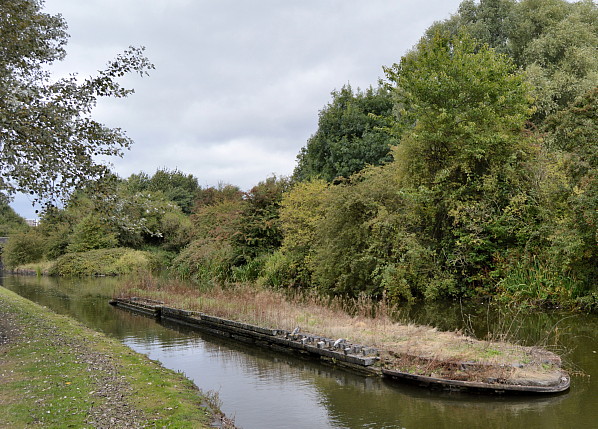
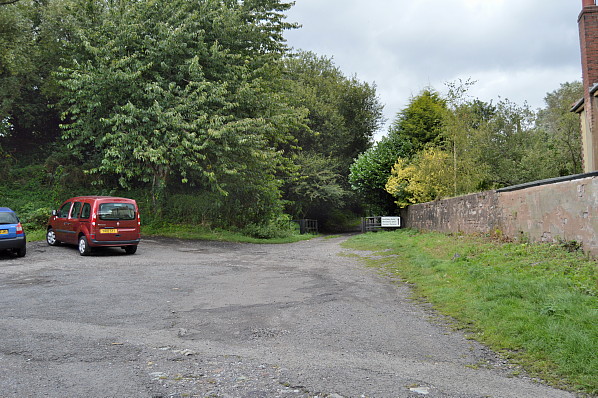



 Home Page
Home Page